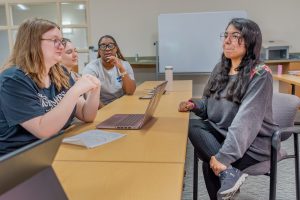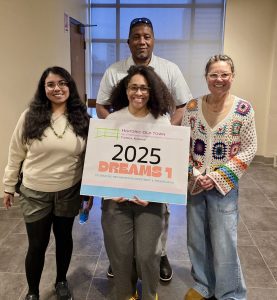Danae Camacho Chevannier was a peer mentor for the Community Studies class taught this spring. Photo by Jeremy Wangler
From The Ichabod – Spring 2025
Story Samantha Marshall
What is a community? Jason Miller used this prompt as the framing question for his Introduction to Community Studies course.
“It seems like a simple question, but, actually, once you get into it, it’s hard to define exactly what a community is,” said Miller, associate professor, anthropology.
Miller and ShaMecha King Simms, president of Topeka’s Historic Old Town Neighborhood Improvement Association, co-designed the class to be a hands-on study of Topeka neighborhoods, allowing students to experience the benefits of being involved as well as the frustrations that come with taking on a larger role.
“People get excited about the change they think they’re going to make but get burnt out trying to do it,” King Simms said. “It’s a slow process. It’s forward and backwards.”
One student’s connection to the coursework impacted not only her fields of study but also the vision she had for her future career. Anthropology major Danae Camacho Chevannier took the class the first semester it was offered. After completing the course, she added a community studies minor, interned for King Simms, then went on to present about her experience alongside Miller and King Simms at the 2024 Michael Tilford Conference on Diversity and Multiculturalism.
Today, she is a peer mentor for the course.

“I’m learning good anthropologists don’t try to study over people, they study with people,” Camacho Chevannier said. “That’s what drew me in.”
For some time, Miller had been interested in designing a course to help students see the value in getting involved. He also saw an opportunity for Washburn to give back to its surrounding neighborhoods.
“I’m interested in reciprocity and being mindful about balance,” Miller said. “I’m always thinking about how to leverage the resources I have as a university professor to help meet community-identified needs.”
Miller found someone who shared his interests when he met King Simms, who also saw the value in helping students better understand the area where they live and attend school by engaging with neighborhood improvement associations.
“NIAs have been looking for ways to get more young people involved,” King Simms said. “We want to hear what their needs are and figure out how to appeal to them.”
Miller and Kings Simms designed the course to have students spend the semester learning about a Topeka neighborhood, then work alongside a community member to complete a project.
Through the course, students have made small but meaningful impacts. For example, one group who worked with the Valley Park neighborhood completed a small research project on flood mitigation. Another group repainted fire hydrants in the North Topeka West neighborhood then went door to door spreading the word about the local NIA.
Camacho Chevannier chose to partner with King Simms’ NIA. Her group completed an asset map for Historic Old Town, which outlined all the highlights of the area. King Simms has used the map to apply for grants, including Dreams 1 designation with the Topeka Dreams Neighborhood Improvement Initiatives Program which will allow Historic Old Town to redo its neighborhood plan and receive $1.7 million in reconstruction funding.

Camacho Chevannier said the course opened her eyes to the realities of struggling communities – as well as the potential that is unlocked when people get involved.
“Disconnection from our environment is unhealthy,” Camacho Chevannier said. “This course showed me the potential of neighborhoods with people who are invested in their communities.”
After creating the course, Miller and King Simms sought to share their takeaways at the Tilford Conference. As they worked through their presentation, they realized the student perspective was missing. Naturally, Camacho Chevannier came to mind.
Miller said attendees were excited to ask Camacho Chevannier questions. For her, participating in the conference helped solidify her future goals.
“It was so empowering. It felt like I found my calling,” she said. “I can see myself creating models of what communities could look like that others can look at and benefit from.”
The three are currently writing about their Introduction to Community Studies experience and hope to submit their work for publication.
“It’s really exciting to publish with a student,” Miller said. “I have a close relationship with one of my advisees and a close relationship with this community partner, and we’re able to do this project together. There’s something about Washburn that encourages that.”
Now on the cusp of being a Washburn alumna, Camacho Chevannier hopes to use her degree to help people in need and get them connected to resources.
“There are so many ways to help people,” she said. “Community studies was my way of helping others.”
1700 SW College Ave., Topeka, KS 66621
785.670.4483
contactus@wualumni.org
Copyrights © 2025 Washburn University Alumni Association and Foundation. All rights reserved. Privacy Policy